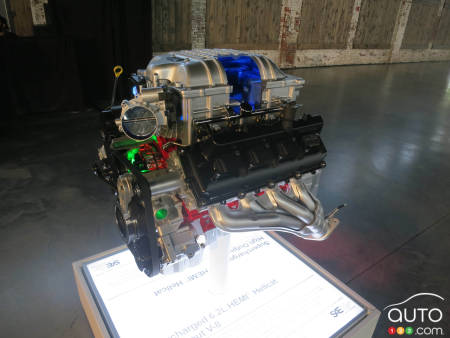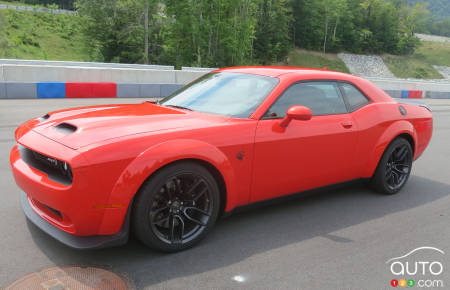There was a time when pony cars (name inspired by the Ford Mustang and its rivals at the) were considered the ultimate incarnation of the sports car in North America. Today, the only ones still standing are the Mustang, the Chevrolet Camaro… and the Dodge Challenger. (The cemetery of muscle car models is littered with evocative names like Mercury Cougar, Pontiac Firebird, Plymouth Barracuda and AMC Javelin).
No doubt about it, the Mustang, which has been in continuous production since its launch back in 1964 (the Camaro and Challenger have had their runs interrupted on occasion), is the undisputed king of the castle. Over time, its GT, Boss and Shelby versions have only added to the popularity of the brand. The Camaro has also attracted its share of fans with the SS and ZL-1. Still, FCA (Fiat Chrysler Automobiles) has to be commended for its genius move of buffing up its Dodge Challenger (revived in 2009) with the new Hellcat division, introduced in 2015.
FCA’s Dodge division is proposing a revised range of its now-legendary Challenger for 2019. The design has been largely left alone (anyways, the career of the original Challenger was so short that it would be futile to present another version!) except for a few esthetic revisions. In short, this range consists of a rear-wheel-drive SXT, an all-new GT with rear-wheel drive, an all-wheel drive SXT, an all-wheel drive GT, and R/T, an all-new R/T Scat Pack, an SRT Hellcat and, especially, the new SRT Hellcat Redeye that we drove and are writing about here.
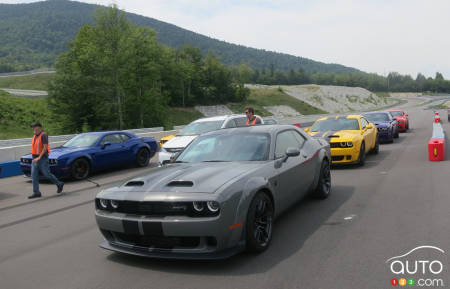
Leaving aside the exterior (or even interior) physical characteristics that differentiate these Challengers, it’s the mechanics that most interest us. It’s important, for starters, to keep in mind that the Challenger models (still built in Brampton, Ontario), are still based on the same platform, based on an “old” Mercedes-Benz architecture; luckily it has been revised and upgraded over the years. Does it really need to be modified or transformed? We’ll see further down.
The best engine of the Challenger models is still the now-legendary Chrysler Pentastar V6, a reliable engine that produces 305 hp. Out of the factory it comes with rear-wheel drive and an 8-speed automatic transmission developed conjointly with German design firm ZF.
You may have noted that all-wheel drive is available, but only with the V6 engine (an option also found with the Dodge Charger and Chrysler 300, both of which share the same platform, and also with the V6 only).
Most of the Challenger’s R/T versions still come with the 5.7L HEMI V8 generating 375 hp and 410 lb-ft of torque with the same 8-speed transmission, or, only with this engine, a 6-speed manual gearbox.
And here’s where it gets interesting. The 2019 Challenger is now available with the 6.2L (or 392 cubic feet) HEMI V8 that delivers 485 hp and 475 lb-ft of torque! And, yes, the manual gearbox is available as well.
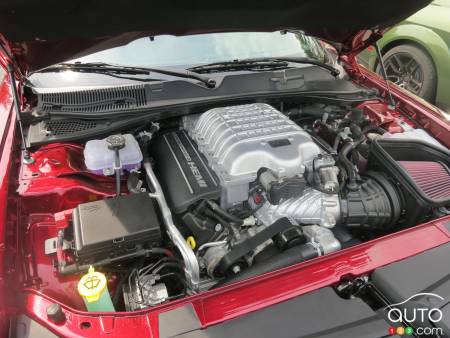
1320
But fans of straight-line racing, who are familiar with the 840-hp Demon (770 lb-ft of torque), the production of which has just ended after its 3,300-unit production run, will be most impressed by the new 1320 version. That name, by the way, is taken from the 1,320-foot unit of distance, better known as the quarter-mile!
That 1320 version, you should know, is only available with the automatic transmission. As you’ll see further down, this is not exactly a fatal flaw for fans of road racing! And if you don’t like the 1320 name, go with the Scat Pack nomenclature, available with the Widebody wing extensions.
SRT Hellcat Redeye
But the showstopper is the 717-hp Hellcat version (available at a more affordable price than before) that is now offered in an incredible SRT Hellcat Redeye version. Its 6.2L HEMI supercharged V8 delivers (hold on to your hat) 797 hp and 707 lb-ft of torque, and takes it from a stop to 60 mph (96 km/h) in only 3.4 seconds, and that quarter-mile can be covered in 10.8 seconds at 131 mph (211 km/h) in Launch mode to minimize wheel spin!
On the track
Unsurprisingly, the Dodge Challenger SRT is at its very best on the track. And this is what FCA wanted to prove to us by having us drive the Scat Pack on a 4-km closed mountainside circuit, complete with tight corners, climbs and descents.
Accompanied by an experienced instructor, we were quickly introduced to the capabilities of the Scat Pack with its Pirelli performance tires and electronic package. In Track mode it manages not only the power of the engine and distribution of power to the wheels but also the automatic transmission, which reacts to accelerations and downshifting without the driver having to do anything but touch the pedals!
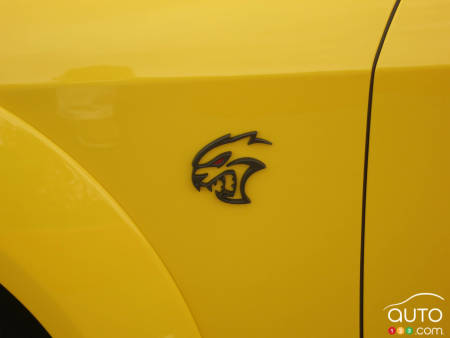
The Challenger Scat Pack holds the track really well and the driver need only use a bit of common sense (or follow the instructor’s directives) to steer the car right. So, to answer the question posed earlier, no, the old Mercedes architecture does not necessarily need to be rejigged!
On to the Hellcat Redeye, a whole other story. This Challenger version (797-hp HEMI engine) comes only with the automatic transmission. The Redeye retains the powerful acceleration of the Demon but grips the track wonderfully. It is, as Steve Beahm, head of FCA’s North American Dodge, SRT, Chrysler and Fiat division said, “a Hellcat possessed by the Demon!”
When in Track mode the Uconnect screen displays the new functionalities of the engine, transmission, power-assisted steering and electronic shocks. This info reveals the true nature of the big Challenger, at heart a big tourer more than it is a straight-line dragster!
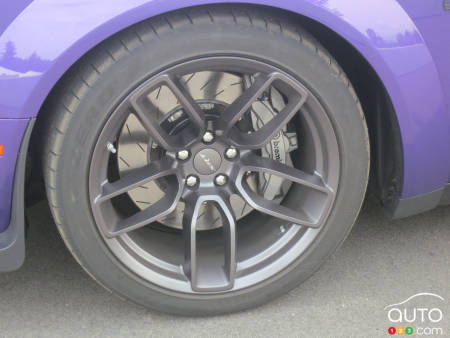
With the help of the extra-sticky Pirelli tires, this big coupe takes corners with ease, its big size be damned. Modulate the accelerator properly, and you can clearly hear the compressor “scream” and even “whistle” to optimize the power of the HEMI engine. Most impressive is the automatic transmission, which climbs up the gears with notable bumps and downshifts automatically when the driver applies the brakes with force.
Despite the Challenger’s age and its older platform, it continues to perform impressively. This pony car has benefited from many technical improvements.
On the day of our first drive no one spoke about fuel consumption, which would have seemed a silly thing to do. FCA does say that the Hellcat Redeye V8 functions optimally with 91-octane super gasoline, so no need to go digging around for 93- or 94-octane fuel to exploit it to the fullest. Did we mention its top speed? No? 203 mph, or 326 km/h. And no, we did not put this claim to the test!
As for the pricing of the 2019 Challenger models in Canada, the SXT base model starts at $36,745, the Scat Pack at $50,945, the 1320 at $54,940 and the top-end Redeye at a mind-boggling $93,695!
